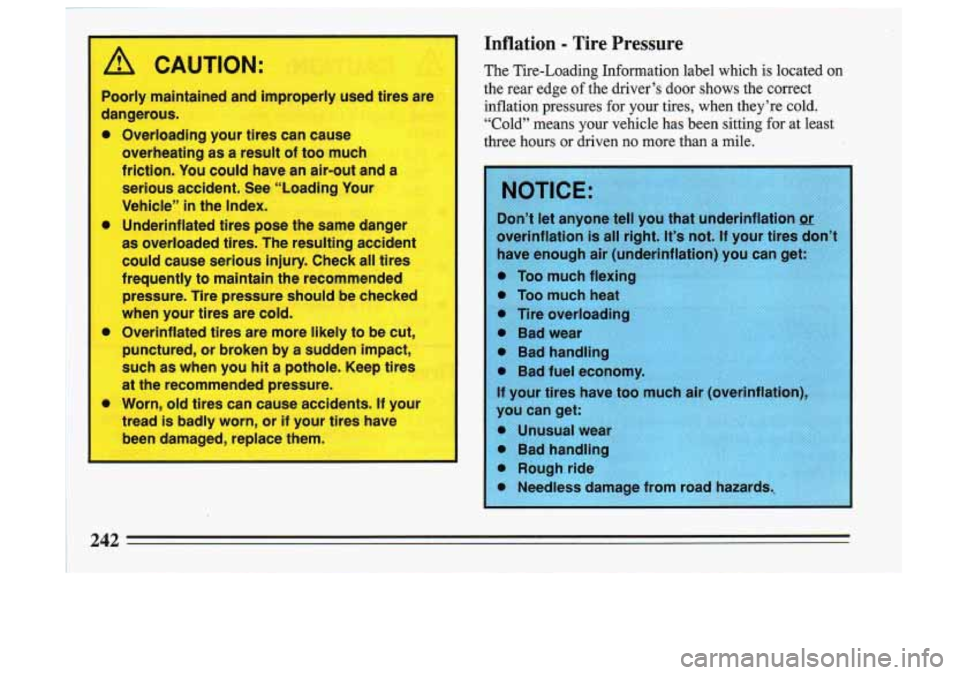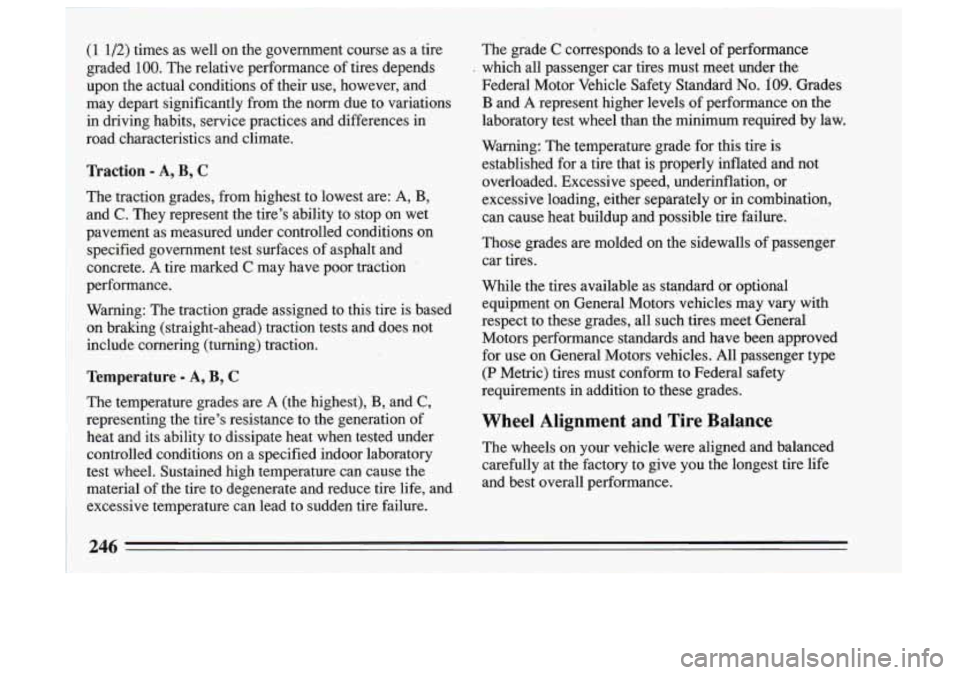1993 BUICK SKYLARK flat tire
[x] Cancel search: flat tirePage 241 of 306

Loading Your Vehicle
TIRE-LOADI',NG INFORMATION
OCCUPANTS
, VEHICLE CAP. WT.
FRT. CTR.
RR. TOTAL LBS. KG
MAX
... LOADING & GVWR SAME AS VEHICLE
CAPACITY WEIGHT- XXX COLD 'TIRE
TIRE SIZE SPEED PRESSURE .R.TG PSI/KPa
FRT.
,., : 3. ~
RR.
SPA.
IF TlRES ARE HOT, ADD 4PSI28KPa
SEE OWNER'S MANUAL
FOR ADDITIONAL
INFORMATION
11)mp .$$##,::
.. ~ c . ., . 'Lj . - .,.
,::.,,: - -i, y- . e,; 2-.,- .- .
Two labels on your vehicle show how much weight it
may properly carry. The Tire-Loading Information label
found
on the rear edge of the driver's door tells you the
proper size, speed rating and recommended inflation
pressures for the tires on your vehicle. It also gives you
important information about the number of people that
can be in your vehicle and the total weight that you can
carry. This weight is called the Vehicle Capacity Weight
and includes the weight of all occupants, cargo, and all
nonfactory-installed options.
,~,,
- -
:.I.
' I
F >
MFD BY GENERAL MOTORS CORP
:.r .~,. a. DATE GVWR' GAWR FRT GAWR RR (1 . -. i < .
THIS VEHICLE CONFORMS TO ALL APPLI-
CA5LE US. FED.ERAL MOTOR VEHICLE
SAFETY, BUMPER, AND THEFT PREVENTION
STANDARDS IN EFFECT
ON THE DATE OF
MANUFACTURE SHOWN ABOVE..
The other label is the Certification label, found on the
rear edge of the driver's door.
It tells you the gross
weight capacity of your vehicle, called the GVWR
(Gross Vehicle Weight Rating). The GVWR includes the
weight of the vehicle, all occupants,
fuel and cargo.
Never exceed the GVWR for your vehicle,
or the Gross
Axle Weight Rating (GAWR) for either the front or rear
axle.
Page 243 of 306

Inflation - Tire Pressure I
I
I
The Tire-Loading Information label which is located on
the rear edge
of the driver’s door shows the correct
inflation pressures
for your tires, when they’re cold,
“Cold” means your vehicle has been sitting for at least
three hours or driven no more than
a mile.
overinflation is all right. it’s not. If your tires d
have enough air (underinflation) you can get:
0 Too much flexin
0 Too much heat
Tire overloadi
0 Bad wear
0 Bad handlin
0 Bad fuel ec
If your tires have too
242
Page 244 of 306

When to Check: Check your tires once a month or
more.
Don’t forget your compact spare tire. It should be at
60
psi (420 Pa).
How tco Check: Use a good quality pocket-type gage to
check tire pressure. Simply looking at the tires will not
tell you the pressure, especially if
you have radial tires --
which may look~properly inflated even if they’re
underinflated. 1
If your tires have valve caps, be sure to put them back
on. They help prevent leaks~ by keeping out dirt and
moisture.
Tire Inspection and Rotation
To make your tires last longer, have them, inspected and
rotated at the mileages recommended in the
Maintenance Schedule. See “Scheduled Maintenance
Services” in the Index. Use this rotation pattern.
After the tires have been rotated, adjust the
front and
rear inflation pressure as shown on the Tire-Loading
Information label. Make certain that all wheel nuts are
properly tightened. See “Wheel Nut Torque” in the
Index.
243
Page 247 of 306

(1 112) times as well on the government course as a tire
graded
100. The relative performance of tires depends
upon the actual conditions of their use, however, and
may depart significantly from the norm due to variations
in driving habits, service practices.and differences in
road characteristics and climate.
’Ikaction - A, B, C
The traction grades, from highest to lowest are: A, B,
and C. They represent the tire’s.ability to stop on wet
pavement
as measured under controlled conditions on
specified government test surfaces
of asphalt and
concrete. A tire marked
C may have poor traction
performance.
Warning: The traction grade assigned to this tire is based on braking (straight-ahead) traction tests and does not
include cornering (turning) traction.
Temperature - A, B, C
The temperature grades are A (the highest), B, and C,
representing the tire’s resistance to the generation of
heat and its ability to dissipate heat when tested under controlled conditions on a- specified indoor laboratory
test wheel. Sustained high temperature can cause the
material of the tire to degenerate and reduce tire life, and
excessive temperature can lead to sudden tire failure. The
grade
C corresponds to a level of performance
Federal Motor Vehicle Safety Standard
No. 109. Grades
B and A represent higher levels of performance on the
laboratory test wheel than the minimum required by law.
Warning: The temperature grade for this tire is
established for a tire that is properly inflated and not
overloaded. Excessive speed, underinflation, or
excessive loading, either separately or in combination,
can cause heat buildup and possible tire failure.
Those grades are molded on the sidewalls of passenger
car tires.
While the tires available as standard or optional
equipment on General Motors vehicles may vary with
respect to these grades, all such tires meet General
Motors performance standards and have been approved
for use on General Motors vehicles. All passenger type
(P Metric) tires must conform to Federal safety
requirements in addition to these grades.
Wheel Alignment and Tire Balance
The wheels on your vehicle were aligned and balanced
carefully at the factory to give you the longest tire life
and best overall performance.
. which all passenger car tires must meet under the
246
Page 268 of 306

Your Vehicle and the Environment
Proper vehicle maintenance not only helps to keep your
vehicle in good working condition, but also helps the
environment. All recommended maintenance procedures
are important. Improper vehicle maintenance or the
removal
of important components can significantly
affect the quality of the-air we breathe. Improper fluid
levels or even the wrong tire inflation can increase the
level
of emissions from your vehicle. To help protect
our environment, and to help keep your vehicle in good
condition, please maintain your vehicle properly.
How This Part is Organized
The remainder of this part is divided into five sections:
“Section A: Scheduled Maintenance Services” shows
what to have done and how often. Some of these
services can be complex,
so unless you are technically
qualified and have the necessary equipment, you should
let your dealer’s service department or another qualified
service center do these jobs.
A CAUTION:
Performing maintenance work on a vehicle can
be dangerous. In trying to
do some jobs, you can
be seriously injured.
Do your own maintenance
work only
if you have the required know-how and
the proper tools and equipment for the job.
If you
have any doubt, have a qualified technician
do
the work.
If you are skilled enough to do some work on your
vehicle, you will probably want to get the service
information GM publishes. You will find a list of
publications and how to get. them in this manual. See
“Service Publications” in the Index.
“Section B: Owner Checks and Services” tells you what
should be checked whenever you stop for fuel. It also
explains what you can easily do to help keep your
vehicle in good condition.
“Section
C: Periodic Maintenance Inspections” explains
important inspections that your Buick dealer’s service
department or another qualified service center should
perform.
Page 278 of 306

At Least Once A Month
CHECK OR SERVICE
Tire Inflation
WHAT TO DO
Check tire inflation. Make sure they
are inflated to the pressures specified
on the Tire-Loading Information
label located on the rear edge of the
driver’s door. See “Tires” in the
Index for further details.
At Least Once A Year
CHECK OR
SERVICE
I WHAT TO DO
Key Lock
Lubricate all body door hinges. Also
Body the
lubricant specified in Section
D. Cylinders Lubricate the
key lock cylinders with
Lubrication lubricate all hinges and latches,
including those for the hood, glove
box door and console door. Section
D tells you what to use.
CHECK OR
SERVICE
Starter Switch
WHAT TO DO
kAUTION: When you are
doing this check, the vehicle
could move suddenly.
If it
does, you or others could be
injured. Follow the steps
bellow.
- 1
1. Before you start, be sure you have
enough room around the vehicle.
2. Firmly apply both the parking brake
(see “Parking Brake” in the Index if
necessary) and the regular brake.
NOTE:
Do not use the accelerator
pedal, and be ready to
turn off the
engine immediately if it starts.
3. Try to start the engine in each gear.
The starter should work only in
“P’
(Park) or “N” (Neutral). If the starter
works in any other position, your
vehicle needs service.
277
Page 303 of 306

Starting Your Car if the Battery is “Dead” .............. 188
Steam From Hot (Overheated) Engine ................ 197
Steering ........................................ 154
Steering in Emergencies ........................... 155
Steering Wheel, Tilt ............................... 88
Steering Without Power Assist ..................... 154
Stereo Sound Systems ............................ 122
Storage Console ................................. 106
Storing Your Vehicle ............................. 237
Stuck. If Your Ignition Key is ....................... 73
Stuck. IfYour Car Is ............................. 213
Subscribing to Buick Product Service Publications ...... 288
Surge Tank Pressure Cap .......................... 233
Symbols on Your Car .............................. 12
Table of Contents ................................. 9
Tachometer ..................................... 1 17
Tamper-Resistant Odometer ........................ 108
Tape Player Care ................................ 133
Temperature. Engine Coolant Warning Light .......... 112
Theft ............................................ 70
Thermostat ..................................... 233
Third Gear ...................................... 78
Tilt Steering Wheel ............................... 88
Time. Setting the ......................... 125.127. 129
Tire Balance .................................... 246
Tire Chains ..................................... 248
Tire. Flat ....................................... 204
Tire Inflation ................................... 242
Tire Inspection and Rotation ....................... 243
Tire Quality Grading ............................. 245
Tires .......................................... 241
Tires. When to Replace ........................... 244
Tires. White Sidewall Cleaning ..................... 254
Torn Safety Belts ................................. 60
Torque Lock (Automatic Transaxle) ................. 174
Towing Your Buick .............................. 193
Towing a Trailer ................................. 179
Trademarks. GM ................................ 216
Traffic Lights ................................... 143
Traffic Officer .................................. 144
Trailer Brakes ................................... 182
Trailer Towing .................................. 179
Transaxle/Transmission. Automatic ................... 77
Transaxle Fluid .................................. 227
Trip Odometer .................................. 108
Trunk Release. Remote ............................ 66
Turn Signal and Headlight Beam Lever ................ 88
Turn Signal “On” Chime ............................ 90
Twisted Safety Belts .. I ............................ 35
Two Children Wearing the Same Safety Belt ............ 58
Turn Signal and Lane Change Indicator ............... 89